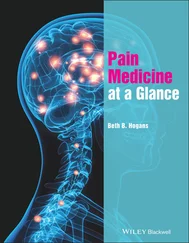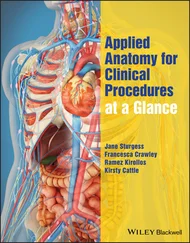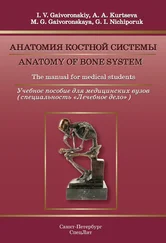Chapters 33–36 Endocrine system
Corticosteroids, e.g. prednisolone, dexamethasone, (bisphosphonates). Sex hormones and drugs: progestogens, e.g. desogestrel. Oestrogens, e.g. ethinylestradiol. Antithyroid drugs, e.g. carbimazole. Antidiabetic drugs, e.g. insulin, metformin. Sulphonylureas, e.g. glicazide. Glitazones, e.g. pioglitazone. Glucagon‐like peptide 2 agonists, e.g. exenatide, liraglutide. Dipeptidyl peptidase 4 inhibitors, e.g. saxagliptin. Sodium glucose co‐transporter‐2‐inhibitors (SGLT‐2 inhibitors), e.g. canagliflozin.
Chapters 37–43 Infectious disease
Antibacterial drugs, e.g. trimethoprim. Quinolones, e.g. ciprofloxacin. Metronidazole, e.g. rifampicin. Penicillins, e.g. benzylpenicillin, amoxicillin, flucloxacillin. Cephalosporins, e.g. cefalexin. Vancomycin. Aminoglycosides, e.g. gentamycin. Macrolides, e.g. erythromycin. Tetracycline, e.g. tetracycline, doxycycline. Antifungal drugs, e.g. amphotericin, econazole, fluconazole. Antiviral drugs, e.g. aciclovir. Antiretroviral drugs, e.g. emtricitabine, efavirenz, saquinavir, dolutegravir. Anthelmintics, e.g. mebendazole, ivermectin, praziquantel. Antimalarial drugs, e.g. primaquine, chloroquine, atovaquone, artemisinin.
Chapter 44 Drugs used in cancer
Alkylating agents, e.g. cyclophosphamide. Antibiotics, e.g. doxorubicin. Antimetabolites, e.g. methotrexate. Taxanes, e.g. Paclitaxel. Monoclonal antibodies, e.g. trastuzumab. Steroid hormonesand antagonists, e.g. prednisolone. Anti‐oestrogens, e.g. tamoxifen.
Chapter 45 Immunosuppressants and antirheumatoid drugs
Immunosuppressants corticosteroids, e.g. prednisolone. Calcineurin inhibitors, e.g. ciclosporin. Monoclonal antibodies, e.g. basiliximab. Tumor necrosis factor alpha (TNF‐α) inhibitors, e.g. infliximab. Anti‐proliferative drugs, e.g. azathioprine. Disease‐modifying antirheumatoid drugs (DMARDS), e.g. methotrexate, sulfasalazine.
Acetylcysteine, naloxone, desferrioxamine.
About the companion website

1
Introduction: principles of drug action
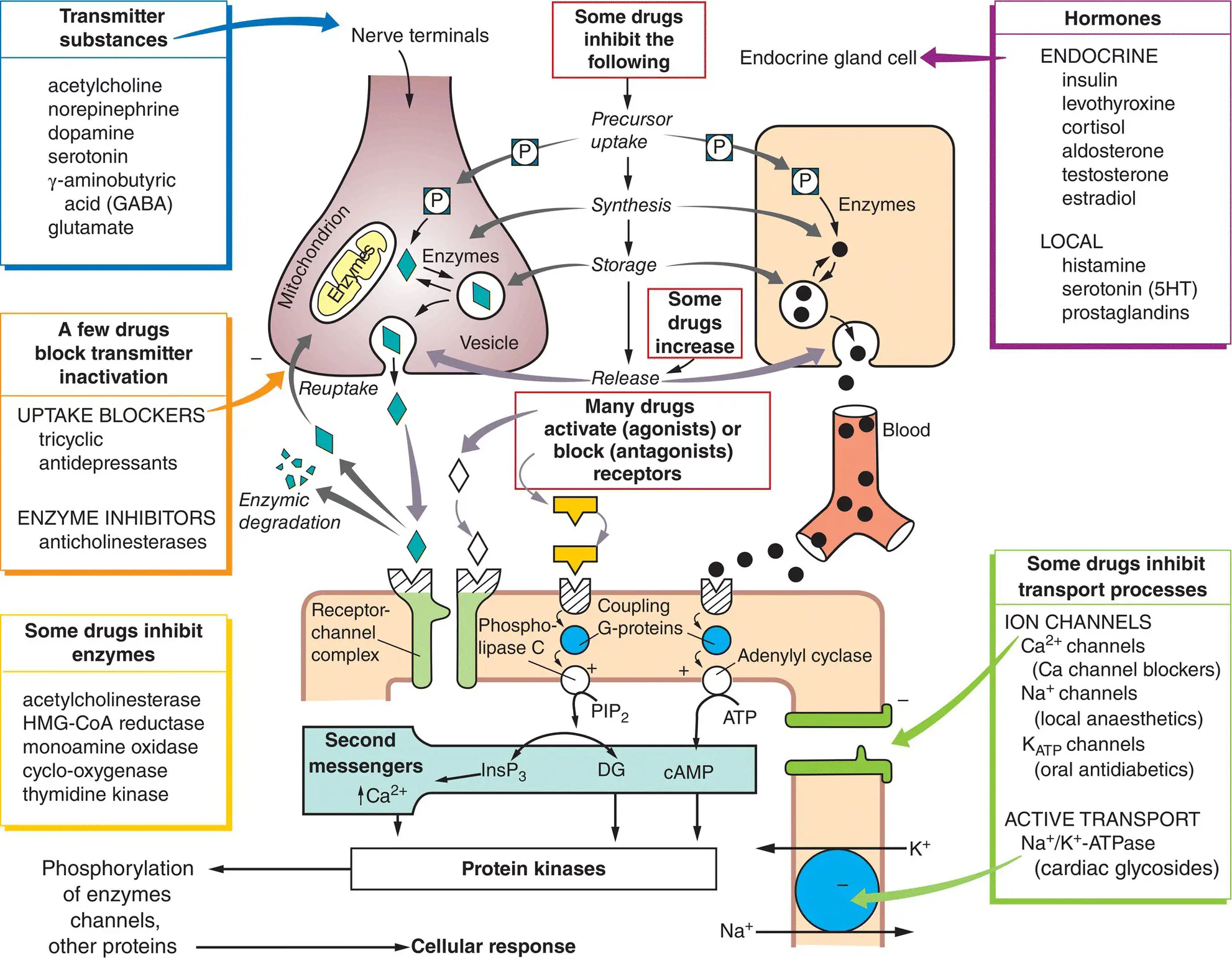
Medical pharmacology is the science of chemicals (drugs) that interact with the human body. These interactions are divided into two classes:
pharmacodynamics – the effects of the drug on the body; and
pharmacokinetics – the way the body affects the drug with time (i.e. absorption, distribution, metabolism and excretion).
The most common ways in which a drug can produce its effects are shown in the figure. A few drugs (e.g. activated charcoal, osmotic diuretics) act by virtue of their physicochemical properties, and this is called non‐specificdrug action. Some drugs act as false substrates or inhibitors for certain transport systems(bottom right) or enzymes(bottom left). However, most drugs produce their effects by acting on specific protein molecules, usually located in the cell membrane. These proteins are called receptors(  ), and they normally respond to endogenous chemicals in the body. These chemicals are either synaptic transmitter substances(top left,
), and they normally respond to endogenous chemicals in the body. These chemicals are either synaptic transmitter substances(top left,  ) or hormones(top right,
) or hormones(top right,  ). For example, acetylcholine is a transmitter substance released from motor nerve endings; it activates receptors in skeletal muscle, initiating a sequence of events that results in contraction of the muscle. Chemicals (e.g. acetylcholine) or drugs that activate receptors and produce a response are called agonists(
). For example, acetylcholine is a transmitter substance released from motor nerve endings; it activates receptors in skeletal muscle, initiating a sequence of events that results in contraction of the muscle. Chemicals (e.g. acetylcholine) or drugs that activate receptors and produce a response are called agonists(  ). Some drugs, called antagonists(
). Some drugs, called antagonists(  ), combine with receptors, but do not activate them. Antagonists reduce the probability of the transmitter substance (or another agonist) combining with the receptor and so reduce or block its action.
), combine with receptors, but do not activate them. Antagonists reduce the probability of the transmitter substance (or another agonist) combining with the receptor and so reduce or block its action.
The activation of receptors by an agonist or hormone is coupled to the physiological or biochemical responses by transduction mechanisms (lower figure) that often (but not always) involve molecules called ‘ second messengers’ (  ).
).
The interaction between a drug and the binding site of the receptor depends on the complementarity of ‘fit’ of the two molecules. The closer the fit and the greater the number of bonds (usually noncovalent), the stronger will be the attractive forces between them, and the higher the affinityof the drug for the receptor. The ability of a drug to combine with one particular type of receptor is called specificity. No drug is truly specific, but many have a relatively selectiveaction on one type of receptor.
Drugs are prescribed to produce a therapeutic effect, but they often produce additional unwanted effects( Chapter 46) that range from the trivial (e.g. slight nausea) to the fatal (e.g. aplastic anaemia).
These are protein molecules that are normally activated by transmitters or hormones. Many receptors have now been cloned and their amino acid sequences determined. The four main types of receptor are listed below.
1 Agonist (ligand)‐gated ion channels are made up of protein subunits that form a central pore (e.g. nicotinic receptor, Chapter 6; γ‐aminobutyric acid (GABA) receptor, Chapter 24).
2 G‐protein‐coupled receptors (see below) form a family of receptors with seven membrane‐spanning helices. They are linked (usually) to physiological responses by second messengers.
3 Nuclear receptors for steroid hormones ( Chapter 34) and thyroid hormones ( Chapter 35) are present in the cell nucleus and regulate transcription and thus protein synthesis.
4 Kinase‐linked receptors are surface receptors that possess (usually) intrinsic tyrosine kinase activity. They include receptors for insulin, cytokines and growth factors ( Chapter 36).
Transmitter substancesare chemicals released from nerve terminals that diffuse across the synaptic cleft and bind to the receptors. This binding activates the receptors by changing their conformation and triggers a sequence of postsynaptic events resulting in, for example, muscle contraction or glandular secretion. Following its release, the transmitter is inactivated (left of the figure) by either enzymic degradation (e.g. acetylcholine) or reuptake (e.g. norepinephrine [noradrenaline], GABA). Many drugs act by either reducing or enhancing synaptic transmission.
Читать дальше
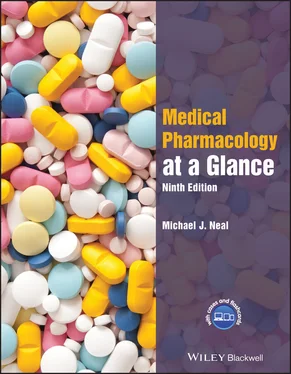


 ), and they normally respond to endogenous chemicals in the body. These chemicals are either synaptic transmitter substances(top left,
), and they normally respond to endogenous chemicals in the body. These chemicals are either synaptic transmitter substances(top left,  ) or hormones(top right,
) or hormones(top right,  ). For example, acetylcholine is a transmitter substance released from motor nerve endings; it activates receptors in skeletal muscle, initiating a sequence of events that results in contraction of the muscle. Chemicals (e.g. acetylcholine) or drugs that activate receptors and produce a response are called agonists(
). For example, acetylcholine is a transmitter substance released from motor nerve endings; it activates receptors in skeletal muscle, initiating a sequence of events that results in contraction of the muscle. Chemicals (e.g. acetylcholine) or drugs that activate receptors and produce a response are called agonists(  ). Some drugs, called antagonists(
). Some drugs, called antagonists(  ), combine with receptors, but do not activate them. Antagonists reduce the probability of the transmitter substance (or another agonist) combining with the receptor and so reduce or block its action.
), combine with receptors, but do not activate them. Antagonists reduce the probability of the transmitter substance (or another agonist) combining with the receptor and so reduce or block its action. ).
).






